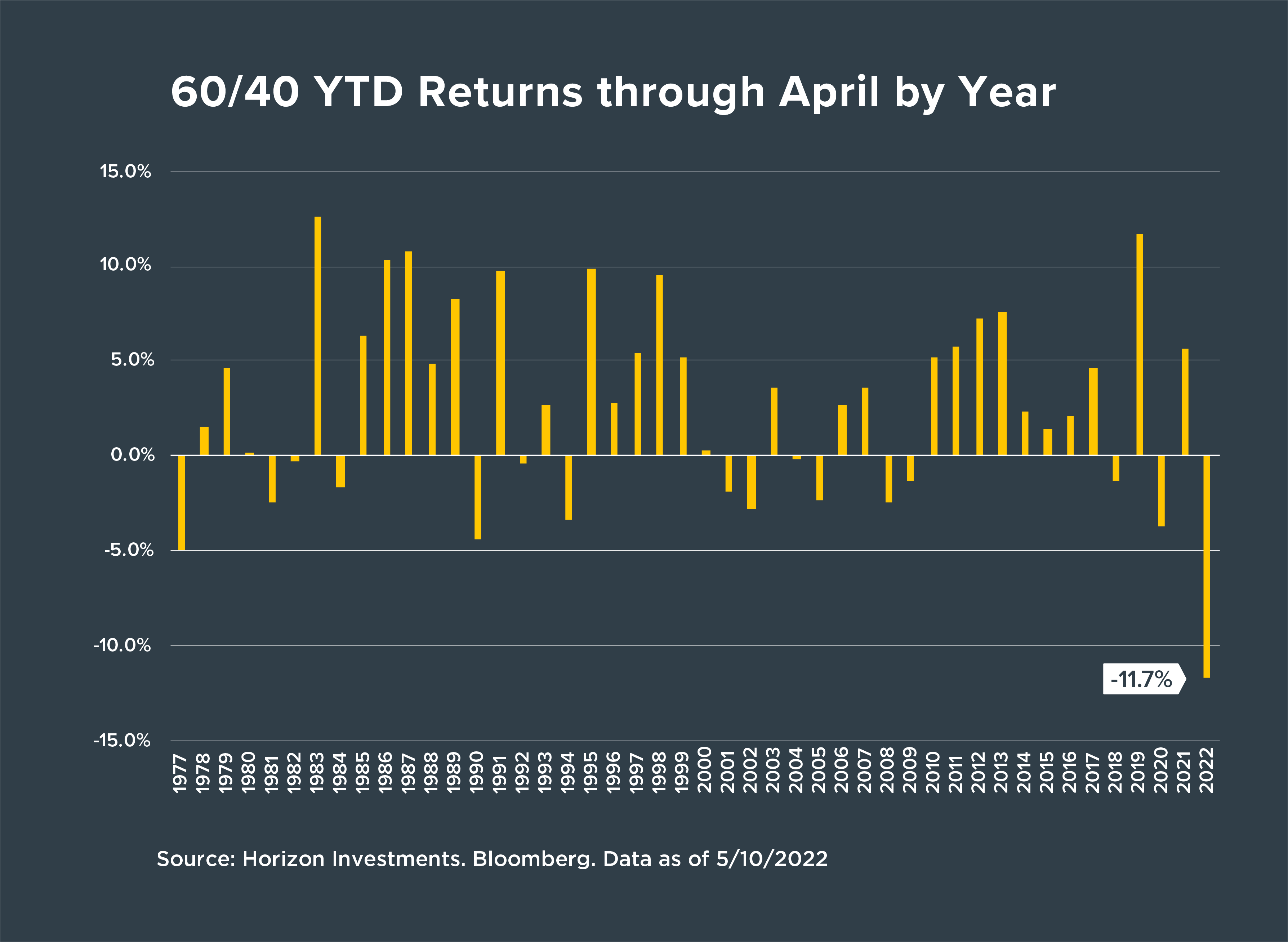Investors in balanced portfolios these days may feel like they’ve fallen off a tightrope.
The classic portfolio of 60 percent equities and 40 percent fixed-income—the foundation of many investors’ financial plans—has plummeted 11.7 percent this year (through April.) That’s far and away the worst four-month calendar-year start for a 60/40 portfolio in the past 45 years, as seen in the chart below. The next worst outcome–a mere -5 percent decline–occurred all the way back in April 1977.

The problem, of course, is that bonds aren’t doing what they’re supposed to—that is, “zig” when stocks “zag.” Instead, both asset classes are cratering, and by relatively similar amounts. While the S&P 500 is down 15.6 percent year to date, the Bloomberg US Aggregate Bond Index (down 9.9 percent) isn’t too far behind. And by one measure—the Bloomberg US Long Treasury Total Return Index—bonds are doing even worse (down 20.7 percent year to date). Such returns thus far have put bonds on track for their worst full calendar year losses on record.
This type of lockstep movement isn’t something investors are used to seeing. Indeed, historically, the usual argument was that the value of having a sizable bond allocation was best seen when stocks stumble. That’s simply not the case so far in 2022, as fears about inflation and the effectiveness of the Fed’s efforts to contain it have given traditional balanced investors few (if any) places to hide.
We recently looked back on quarters when both stocks and bonds posted negative returns and found that since 1976, the average year-over-year inflation rate during these periods was 6.1 percent. In stark contrast, the average inflation rate during those quarters when fixed-income allocations provided a diversification benefit– when bonds were up while stocks fell–was just 3.3 percent. If inflation remains elevated, history tells us that bonds’ diversification benefit may continue to be challenged.
The upshot: It may be good time to rethink traditional approaches to diversification. Using equities with defensive qualities to keep the equity beta stable versus a traditional 60/40 portfolio, while reducing sensitivity to the bond market, may be a possible solution. We explore three potential solutions for advisors looking to implement a defensive 80/20 portfolio strategy in our blog here.
1As measured by 60% S&P 500 price index and 40% Bloomberg Aggregate bond index
2As of 5/10/2022
3Beta is a measure of volatility, or systematic risk, of a security compared with the overall market volatility.
This commentary is written by Horizon Investments’ asset management team. For additional commentary and media interviews, contact Chief Investment Officer Scott Ladner at 704-919-3602 or sladner@horizoninvestments.com.
Nothing contained herein should be construed as an offer to sell or the solicitation of an offer to buy any security. This report does not attempt to examine all the facts and circumstances that may be relevant to any company, industry or security mentioned herein. We are not soliciting any action based on this document. It is for the general information of clients of Horizon Investments, LLC (“Horizon”). This document does not constitute a personal recommendation or take into account the particular investment objectives, financial situations, or needs of individual clients. Before acting on any analysis, advice or recommendation in this document, clients should consider whether the security in question is suitable for their particular circumstances and, if necessary, seek professional advice. Investors may realize losses on any investments. Index information is intended to be indicative of broad market conditions. The performance of an unmanaged index is not indicative of the performance of any particular investment. It is not possible to invest directly in an index.
Past performance is not a guide to future performance. Future returns are not guaranteed, and a loss of original capital may occur. This commentary is based on public information that we consider reliable, but we do not represent that it is accurate or complete, and it should not be relied on as such. Opinions expressed herein are our opinions as of the date of this document. These opinions may not be reflected in all of our strategies. We do not intend to and will not endeavor to update the information discussed in this document. No part of this document may be (i) copied, photocopied, or duplicated in any form by any means or (ii) redistributed without Horizon’s prior written consent.
Other disclosure information is available at hinubrand.wpengine.com.
Horizon Investments and the Horizon H are registered trademarks of Horizon Investments, LLC
©2022 Horizon Investments LLC
